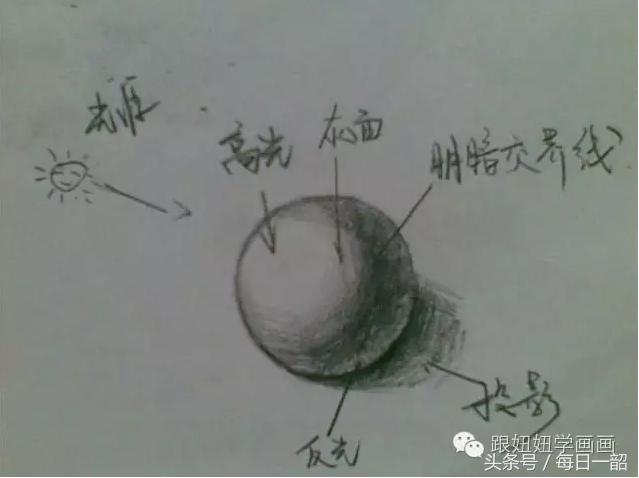Perspective! It is the spatial relationship between near big, far small, near high, far low, near real, far and empty in our painting. In the sketch, there are no completely parallel lines, and then the parallel lines look at it from a distance, but also meet at one point, so there is the above perspective relationship.
Here comes the important ~
When drawing, first find the light-dark boundary of the object. The line starts from the light-dark boundary. Following the light-dark boundary, the layers deepen and transition. The intersection of the object and the projection must be the deepest, so that the object will have quality. Then transition to the bright side, until the picture is complete...
In fact, drawing is not difficult at all. All things are painted in the same way. Type, find the boundary between light and dark, transition, and projection is OK...
Here are some details that beginners should pay attention to:
1. The lines should not be too messy or too loose
2. When drawing an object where a cylinder and a cone cross intersect, the positions of the cylinders on both sides must be on a line
3. The bottom surface of the cone must not have an angle.
5. Light and dark transition should be natural
6. The contrast between light and dark should be strong, the black is black, and the light is bright (otherwise it will be grayed out, that is, the black is not black enough, the white is not white enough, almost all are gray transitional)
7. Keep the screen tidy (otherwise it will be dirty)
8. Where there is a projection, the border between light and dark must be found!
The assembled plaster must be painted together when painting, which is the whole we have always said. The steps are:
1. Determine the highest and lowest points of the overall picture, the position of each object,
2.Styling, using the flick of a side striker, simply determine their approximate shapes, and then make sure that they are correct, and outline their specific shapes (note the perspective relationship: near big, far small)
3. Find out all the light and dark junctions,
4. Simultaneous light and dark, including projection and gray surface painting together (otherwise it is easy to spend, that is, the parts of the picture are not unified) (note the perspective relationship: near reality and far reality)
5. It is recommended to find some black objects with smooth surfaces, such as vases.
Attention is an affirmation and encouragement to Niuniu.
Ball
Imagine that when there is light, we see a ball, and then this ball has a light-receiving surface and a back-light surface, as well as a highlight (brightest) and a gray surface (in the transition area from the highlight to the light-dark boundary) Light-dark boundary (the deepest, all along the structure), reflection (the external influence on the object), projection (shadow).Here comes the important ~
When drawing, first find the light-dark boundary of the object. The line starts from the light-dark boundary. Following the light-dark boundary, the layers deepen and transition. The intersection of the object and the projection must be the deepest, so that the object will have quality. Then transition to the bright side, until the picture is complete...
In fact, drawing is not difficult at all. All things are painted in the same way. Type, find the boundary between light and dark, transition, and projection is OK...
Here are some details that beginners should pay attention to:
1. The lines should not be too messy or too loose
2. When drawing an object where a cylinder and a cone cross intersect, the positions of the cylinders on both sides must be on a line
3. The bottom surface of the cone must not have an angle.
Cone
4. The intersection of the projection and the object must be bolder and deeper, the wrong one and the eraser5. Light and dark transition should be natural
6. The contrast between light and dark should be strong, the black is black, and the light is bright (otherwise it will be grayed out, that is, the black is not black enough, the white is not white enough, almost all are gray transitional)
7. Keep the screen tidy (otherwise it will be dirty)
8. Where there is a projection, the border between light and dark must be found!
The assembled plaster must be painted together when painting, which is the whole we have always said. The steps are:
1. Determine the highest and lowest points of the overall picture, the position of each object,
2.Styling, using the flick of a side striker, simply determine their approximate shapes, and then make sure that they are correct, and outline their specific shapes (note the perspective relationship: near big, far small)
3. Find out all the light and dark junctions,
4. Simultaneous light and dark, including projection and gray surface painting together (otherwise it is easy to spend, that is, the parts of the picture are not unified) (note the perspective relationship: near reality and far reality)
5. It is recommended to find some black objects with smooth surfaces, such as vases.
Attention is an affirmation and encouragement to Niuniu.
Source: KKnews








No comments